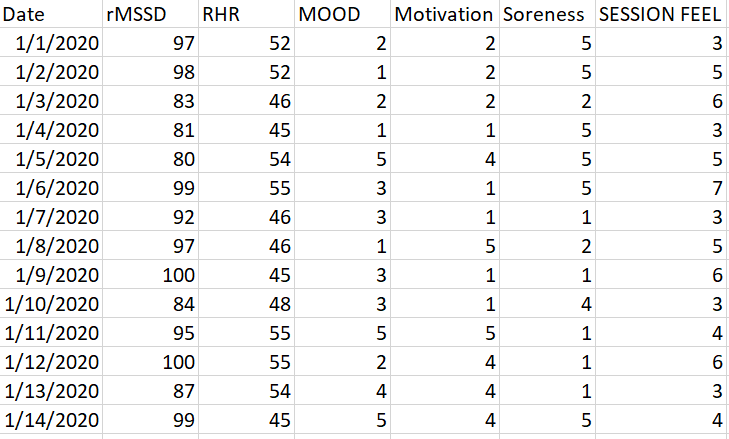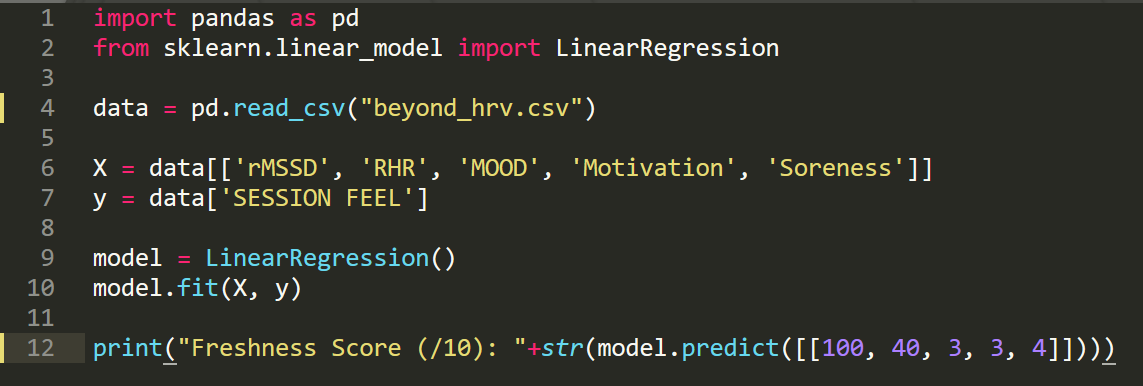Integrated Athlete Monitoring: Taking the step beyond HRV
Alan Couzens, M.Sc. (Sports Science)

If you’ve read my blog for any period of time, you know by now that I am very much an advocate for using Heart Rate Variability to guide the training process. It’s been my experience that implementing HRV monitoring as a part of the decision making process not only helps the coach/athlete to steer clear of overtraining, it also helps to ensure that the athlete maintains a high response to the training that they perform, i.e. that they get the highest possible fitness return for every training 'buck' they spend.
Many studies have supported this idea that using a HRV guided approach vs a more traditional 'fixed' approach results in superior training adaptations for a given load. Only last month, the latest in a long line of studies supporting this hypothesis was released. Alejandro Javaloyes and colleagues compared a HRV guided approach vs a Block Periodization approach in a group of twenty well trained cyclists over 8 weeks of training and found significant improvements in VO2max, peak power output, watts at VT1 and VT2 and Time Trial performance for the HRV guided group. Perhaps more importantly, when looked at individually, all but one of the cyclists improved using the HRV guided approach, while on the block periodization approach, ~half exhibited better performance while ~half exhibited WORSE performance after the 8 week training period! (see below)
Fantastic new study by @theplews1 @alejandro_java on the benefits of a #HRV guided approach vs a fixed periodization model.
— Alan Couzens (@Alan_Couzens) May 27, 2020
This figure on 40KTT improvement between groups sums it up. When the program is *individualized* to #HRV, everyone gets better! https://t.co/UA6B76t1o7 pic.twitter.com/yZfLQQhyZF
The above speaks to the real strength of using a HRV guided, or really an individually guided, approach to training. By simply adopting the approach of moving the training around depending on the athlete’s state on any given day, the chance of the athlete positively adapting to and responding to the training is significantly increased! After playing around with HRV in my training and the training of my athletes over the past decade, I can personally attest that the simple act of checking in on the athlete’s HRV before planning the next training week goes a long way towards decreasing the prevalence of injury, illness and non functional over-reaching within your training squad!
However, as powerful as HRV is, it is still only one number. A common argument made by athletes who experiment with HRV monitoring for a short period of time is that "I didn’t feel it lined up with how I was feeling or how I was performing" and, there is some truth to this...

While there is almost always a correlation between HRV and subjective feel when viewed over a sufficient period of time, there are also plenty of individual sessions (individual 'dots' on the above chart) where HRV may be relatively low and the athlete may still feel great. Similarly, there are often sessions where HRV is really high and the athlete feels like, and performs like crap! In fact, the latter situation is relatively common and speaks to the problem of only looking at one measure...
Following a big training camp, athletes will often exhibit very *high* HRV for several days despite feeling very tired and being unable to train at normal levels. This 'parasympathetic overdrive' is one situation where one number just doesn’t cut it. Another situation that I commonly run into is, when an athlete is peaking and race excitement/nerves are building, HRV will often take a down-turn. This is in no way indicative of the readiness of the system to perform, if anything, it is a positive indication that the athlete’s autonomic nervous system is gearing up for a fight!
Clearly, it’s helpful to add some additional context to the HRV measures in order to be able to more accurately ascertain just what they mean with regards to the optimal training decisions to make. For example, in the above scenarios, if we simply knew the athlete’s Training Stress Balance ( the ratio of acute:chronic training load), we would be in a much better position to interpret the high or low heart rate variability values…
- TSB very low and HRV very high = athlete in rest and recovery mode after a big training dose.
- TSB high and HRV high = athlete ready for work!
This simple example shows the power of adopting a multi variable approach to your decision making model. The addition of each feature can add some really important context that is not explained by any single feature alone. This is very much a situation where the whole is far greater than the sum of its parts. In fact, statistically greater!
While all metrics (training load, #HRV, subjective wellness ratings) are helpful in assessing athlete fatigue, the real magic comes when they are brought together in a single model.
— Alan Couzens (@Alan_Couzens) May 11, 2020
Truly a case where the whole is so much greater than the sum of its parts. pic.twitter.com/a0oOAt5UqU
By using a multi variable model that incorporates heart rate variability measures, resting heart rate, training stress balance, and subjective markers (mood, motivation, tiredness), the ability of the model to reflect how an athlete will both tolerate and respond to a given training stress is significantly improved far beyond the sum of the individual predictive ability of the single features. Again, this is due to the context provided when looking at these numbers together…
While not all athletes will exhibit the same difference between a multi-variable and a single variable approach, every athlete that I have compared a multiple metric model to a single metric model, has shown model performance on the test set of the multi-variable model far greater than the sum of the individual model parts.
Another example – By simply looking at resting heart rate and HRV together, Ithlete Pro uses this additional dimension to define an athletes state in four quadrants – stressed, energized, exhausted, tired, again using the power of the additional context added by the introduction of another variable to distinguish between those times when the athlete’s HRV is high due to extreme fatigue and an overdrive of the parasympathetic nervous system vs when the HRV is high due to a readiness for work. With this extra dimension comes extra power. If we visualize it as a cube with an additional dimension of the athlete's mood, we would have an even more accurate map of the athlete's current state.
So, how do we implement the above in a practical context?
An experienced coach is able to do a lot of this 'context weighing' in their head. By knowing where the training load currently is, the objective markers of the athlete’s state – HRV, RHR etc, along with the subjective indicators of an athlete’s state – "How are you feeling?", "How are you sleeping?" "You look to be moving a little stiff today?" the coach puts all of these factors together in his/her brain, weighs them in accordance with knowing the athlete and makes a decision on that basis. Of course, doing this right is a time & labor intensive process, a process that can be significantly helped out, in my opinion, by technology.
With the implementation of some very basic machine learning, this 'gathering and weighing of the inputs' can be done by a machine, resulting in all factors being weighed appropriately for a given athlete and 'spat out' into one simple "freshness score" that the coach can act on.
Many powerful models can be applied to this problem, including recurrent neural networks that incorporate trends in the athlete’s data over time, i.e a situation where HRV has been low over the past week will be weighted differently to a single low reading. I'm using these techniques currently in my work with HumanGo.ai However, even a simple linear regression approach represents a powerful step forward in bringing the data points that are being collected together to individually guide the training. With a simple dataset along the lines of…

The coach can use the following code to go a step beyond HRV monitoring by pulling multiple features into one simple predictive number of an athlete’s readiness for training, i.e. how he/she is likely to feel during today’s session.

If I run the above code on that sample data – rMSSD of 100, RHR of 40, mood of 3/5, motivation of 3/5 and soreness of 4/5, I get…
Freshness Score (/10): [3.07711214]
i.e., despite a really high HRV, the predicted freshness is not great! Our model is able to take into account the context that, even though rMSSD is high (at 100) it is coupled with a really low RHR and a high soreness. This gives some additional useful information and a more accurate assessment of the athlete's state.
If the athlete is likely to feel not great, the coach might plan an easy session. If the athlete is likely to feel “on fire”, the coach might plan an intense session. Importantly, this same approach can be applied not only to how the athlete will feel, but also how the athlete is likely to perform – creating a holistic snapshot of the athlete's state.
Importantly, this approach weights the value of each feature for different athletes. For example, if we compare the athlete’s mood rating above with how he feels during the session, we see there is little correlation. He is often in a bad mood but feels great during training. While, for some athletes, sliding mood indicates excessive fatigue, some athletes might just be grumpy bastards with no relationship at all to their readiness to train 😊
Maybe a little less intuitively, the same can be said for HRV. Some athletes will exhibit HRV numbers that swing around a lot due to instability of the system or instability of life, i.e. some athlete’s HRV will be significantly more ‘noisy’ than others when it comes to predicting how they will tolerate and respond to a training session. For some, changes in HRV are very meaningful with respect to fatigue. For others, much less so & it is for these other athletes with a lot more noise in the system, that the introduction of additional inputs is especially useful.
In summary, while the power of using HRV to guide the training can’t be denied, the true power lies in responding individually to an athlete’s state. It’s my assertion that by adding additional inputs to this assessment of the athlete’s state, we add important contextual information that actually boosts our ability to accurately interpret changes in HRV. Furthermore, by applying some basic ML techniques to link these inputs with how an athlete feels and performs, we can significantly cut down on the mental grunt work of weighing all of these variables in your head for a given athlete and making the optimal decision for any given day.
Train smart,
AC
TweetDon't miss a post! Sign up for my mailing list to get notified of all new content....
